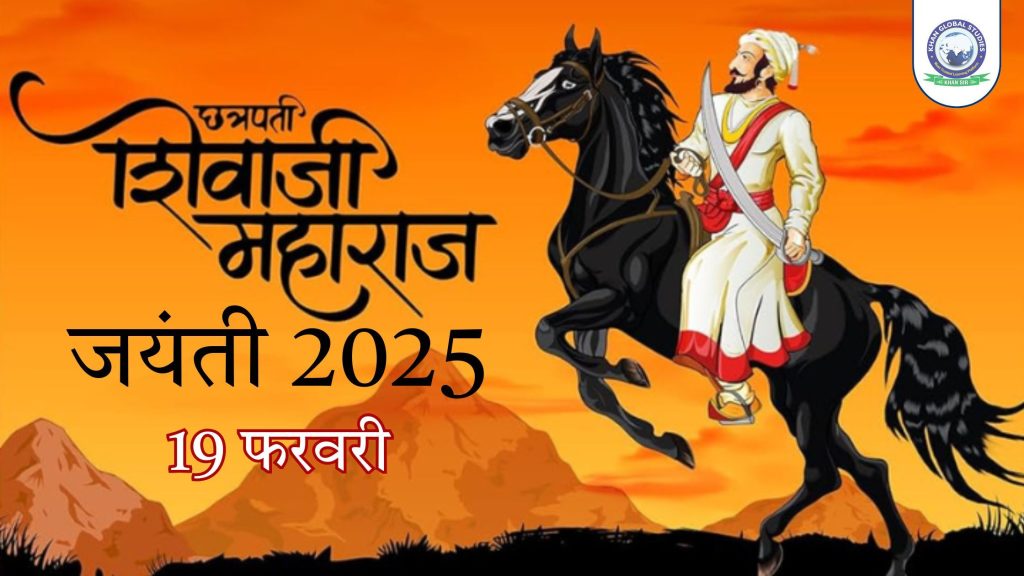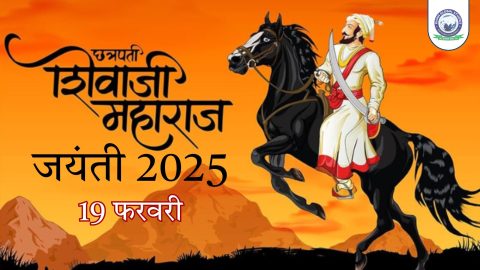Shivaji Maharaj Jayanti is celebrated every year on February 19 to mark the birth anniversary of Chhatrapati Shivaji Maharaj, the founder of the Maratha Empire and one of India’s greatest warriors. With his courage, strategy, and patriotism, he established a strong and independent Hindavi Swaraj.
Early Life
Shivaji was born on February 19, 1630, at Shivneri Fort, near Junnar in Pune district. Some historians have different views on his birth date, but the Maharashtra government officially celebrates it on February 19. He was named after the goddess Shivai, worshiped at Shivneri Fort.
Shivaji belonged to the Bhosale Maratha clan. His father, Shahaji Bhosale, was a military commander in various Deccan Sultanates, while his mother, Jijabai, was the daughter of Jadhavrao Sardar of Sindkhed, who claimed descent from the Yadava dynasty. His grandfather, Malojirao Bhosale, was a respected general in the Ahmadnagar Sultanate and was granted control over Pune, Supa, Chakan, and Indapur. Jijabai inspired young Shivaji with stories from the Ramayana, Mahabharata, and other religious texts, which ignited his dream of Swaraj (self-rule) from an early age.
Coronation and Administration
In 1674, Shivaji was crowned as Chhatrapati (ruler) of the Maratha Empire. Some local Brahmins opposed his coronation, but he was widely recognized as a just and noble ruler. He was known for his fair governance and respect for women. His administration and military included people from all castes and religions, including Muslims and Europeans. He strengthened the Maratha Navy and built an extensive network of forts to protect his kingdom.
Shivaji’s Military Tactics and Strategies
Shivaji was an expert in military strategy and used guerrilla warfare tactics (known as Ganimi Kava) to defeat powerful Mughal and Deccan Sultanate armies. He captured many forts using clever war tactics and strategic planning.
Conflicts with the Mughals and Other Sultanates
Throughout his life, Shivaji had both alliances and conflicts with major powers like the Mughal Empire, Golconda Sultanate, Bijapur Sultanate, and European forces. At one point, he even offered military support to the Mughal Emperor Aurangzeb to attack Bijapur. However, when Aurangzeb shifted his focus north, Shivaji took back several territories handed over to the Mughals.
In 1665, after losing the Battle of Purandar to Mughal General Jai Singh I, Shivaji accepted Mughal sovereignty and was given the title of “Raja”. He even participated in Mughal military campaigns for a brief period.
Conflict with Bijapur and Steps Toward Independence
In 1636, the Bijapur Sultanate invaded the southern Deccan, and Shivaji’s father Shahaji participated in the campaign. Later, in 1646, at just 16 years old, Shivaji captured Torna Fort through diplomacy and strategy. Using the treasure found in Torna, he built Raigad Fort, which later became his capital.
As Shivaji’s power grew, the Bijapur Sultanate imprisoned his father Shahaji in 1648. After his release in 1649, Shivaji resumed his military campaigns. By 1656, he had captured Javali Valley, further strengthening his hold over southern and western Maharashtra.
Key Achievements of Shivaji Maharaj
- Establishment of Swaraj: Shivaji fulfilled the vision of Hindavi Swaraj and laid the foundation of an independent Maratha Empire.
- Conquering Forts: He captured several important forts like Torna, Raigad, Rajgad, Sinhagad, and Pratapgad.
- Defeat of Afzal Khan: In 1659, he defeated Afzal Khan, a commander of Bijapur, strengthening Maratha power.
- Resistance Against the Mughal Empire: Shivaji fought many battles against Aurangzeb’s mighty army and successfully defended his kingdom.
- Coronation: On June 6, 1674, he was crowned at Raigad Fort as Chhatrapati (Emperor).
- Administrative and Social Reforms: He introduced significant reforms in agriculture, law, and naval defense.
Death and Succession Disputes
Shivaji died between April 3-5, 1680. The exact cause of his death is uncertain; some sources suggest high fever, while others mention anthrax.
After his death, his wife Soyarabai tried to place their son Rajaram on the throne. However, Shivaji’s elder son, Sambhaji, took control of Raigad Fort and became ruler on July 20, 1680. Soyarabai and Rajaram were later imprisoned, and Soyarabai was executed in October 1680.
Shivaji’s Legacy in Modern India
During India’s freedom struggle, social reformer Jyotirao Phule revived the stories of Shivaji’s bravery. Later, Bal Gangadhar Tilak and other nationalists regarded him as an inspiration.
Today, especially in Maharashtra, Shivaji is honored as a national hero. His legacy is an integral part of Marathi culture and history. While some groups try to portray him only as a Hindu king, historical records show that he was a secular ruler who respected all religions.
Shivaji Maharaj was not just a warrior, but also a wise administrator and a leader who cared for his people. He protected women, ensured justice for all, and implemented policies that remain relevant even today.
Celebration of Shivaji Jayanti
In Maharashtra and other parts of India, Shivaji Jayanti is celebrated with great enthusiasm. People garland his statues, organize processions, recite his heroic tales, and remember his inspiring leadership.
Conclusion
Chhatrapati Shivaji Maharaj was not only the founder of the Maratha Empire but also one of India’s greatest warriors and leaders. His life, struggles, and victories continue to inspire every Indian.
Shivaji Jayanti reminds us of the values of patriotism, bravery, and self-respect.





